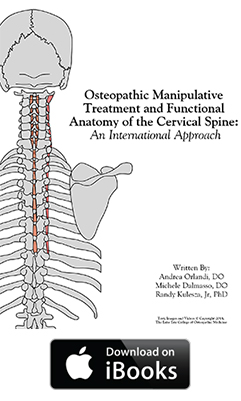A new ebook published by the Lake Erie College of Osteopathic Medicine (LECOM) offers insightful, detailed instruction on Osteopathic Manipulative Treatment (OMT) techniques and is written from the perspective of both Italian and American physicians.

The ebook is designed for both medical school students and practicing physicians and is now available for the iPhone, iPad, iPod touch, and Mac.
“The book is based on musculoskeletal anatomy, physiology-biomechanics, and pathology and reflects how traditional osteopathic techniques have evolved,” said Andrea Orlandi, DO, a faculty member at the Accademia Italiana Medicina Osteopatica (AIMO) in Saronno, Italy. Dr. Orlandi is the co-author of OMT and Functional Anatomy of the Cervical Spine along with Michele Dalmasso, DO, also a faculty member at AIMO, and Randy Kulesza, Ph.D., and Richard Raymond, Ph.D., faculty members at LECOM.
The book, OMT and Functional Anatomy of the Cervical Spine, is now available at the Apple iTunes Bookstore for $29.99 for the iPhone, iPad, iPod touch, and Mac. The authors hope the book will help both medical school students and practicing physicians further their understanding of osteopathic manipulative treatment (OMT) and advance osteopathic medicine generally.“Students who attend an osteopathic school are required to study osteopathic manipulative techniques that address both anatomical-biomechanical-pathological topics and clinical-practical areas,” the book’s preface notes. “For this reason, it is both necessary and practical to have an educational resource that contains, in detail, all of the pertinent and applicable information, easily accessed anytime, for review of both the basic musculoskeletal knowledge and osteopathic techniques.”OMT and Functional Anatomy of the Cervical Spine includes extensive overviews of osteopathic manipulative techniques that are accompanied by high-definition videos:
- Soft Tissue – a direct technique typically involving lateral stretching, linear stretching, deep pressure, traction, and/or separation of muscle origin and insertion while monitoring tissue response and motion changes by palpation.
- Direct Joint Mobilization – low velocity/moderate-to-high amplitude technique in which a joint is carried through its full motion with the therapeutic goal of increased range of movement. The activating force is either a springing motion or repetitive concentric movement of the joint through the restricted barrier.
- Spine Intervertebral Disc Rehab – employs a slow, therapeutic force of long duration that is applied on the specific vertebral unit, whose disc is affected by a disc degeneration problem, in a simple or combined direction of motion according to the direction of the disc degeneration. The therapeutic goal is to increase the shift/slide motion of the specific intervertebral disc during the biomechanical movement of the spine.
- Specific Joint Traction – employs a slow, therapeutic force of long duration that is applied lengthwise along the entire cervical spine or on the specific vertebral unit, acting both on the facet joint (affected by osteoarthritic degeneration) and/or on the intervertebral disc (affected by bulging, derangement, herniation). The objective is to increase elasticity of the spine facet joint capsule and ligaments and to reduce the compression on the intervertebral disc affected.
- HVLA (high velocity, low amplitude) – also known as the thrust technique, employs a rapid, therapeutic force of brief duration which travels a short distance within the anatomic range of motion of a joint and which engages the restrictive barrier in one or more planes of motion to elicit release of restriction.
In order to help readers better understand each of the techniques, the book includes supplemental information, including a step-by-step explanation of the technique, the relative degree of difficulty in administering it, the proper duration, and common mistakes made in performing the technique.OMT and Functional Anatomy of the Cervical Spine also includes:
- Important concepts related to Osteopathic Manipulative Treatment, including a thorough evaluation and determination of the patient’s health in order to assess whether OMT is an appropriate method of treatment.
- An overview of the embryology of the cervical spine, biomechanics, and neurology, including how structure, function, and dysfunction of the cervical spine are related to the spinal cord and associated spinal nerves.
- The importance of physicians explaining to patients how the particular technique will be performed.
- The need for physicians to remain mindful that musculoskeletal conditions can be caused by a number of factors, including age, posture, occupation, hobbies and athletic activities, and lifestyle factors such as diet and weight.
Dr. Orlandi and Dr. Dalmasso will offer a presentation on the book at the American Osteopathic Association’s (AOA’s) Annual Osteopathic Medical Conference and Exposition in October.More about the authorsDr. Orlandi and Dr. Dalmasso graduated with five-year degrees in Osteopathic Manipulative Techniques at the Istituto Superiore di Osteopatia in Milan, Italy, and at the University of Wales, UK. They also earned Master’s degrees in Osteopathy at Bicocca University in Milan, Italy. Their professional collaboration with LECOM and John Ferretti, DO, the College’s President and CEO, and Silvia M. Ferretti, LECOM’s Provost, Senior Vice President, and Dean of Academic Affairs, dates to 2006.Randy Kulesza, Ph.D., is Assistant Dean of the Post Baccalaureate and Master’s in Biomedical Science programs and Associate Professor of Anatomy at LECOM. He earned a doctoral degree in Anatomy/Neuroscience at West Virginia University.Richard Raymond, Ph.D., is Professor and Director of Pathology at LECOM and serves as the Director of the College’s Primary Care Scholars Pathway. He graduated from Michigan State University with master’s and doctoral degrees in physiology.

